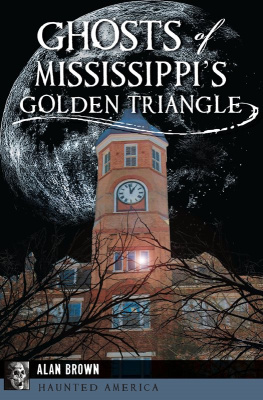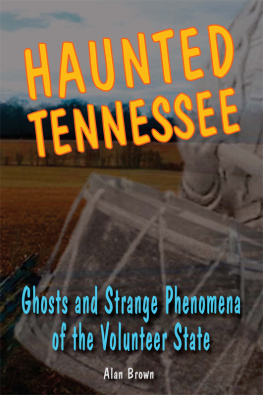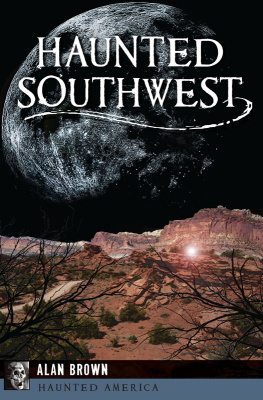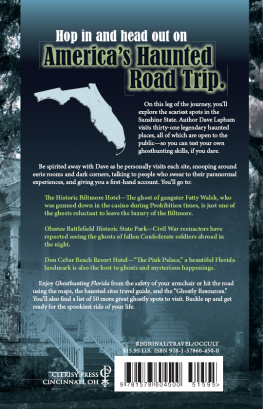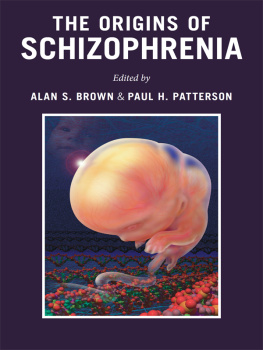

Published by Haunted America
A Division of The History Press
Charleston, SC 29403
www.historypress.net
Copyright 2013 by Alan Brown
All rights reserved
Unless otherwise noted, all images appear courtesy of the author.
First published 2013
e-book edition 2013
Manufactured in the United States
ISBN 978.1.61423.971.0
Library of Congress Cataloging-in-Publication Data
Brown, Alan, 1950 Jan. 12-
Haunted Big Bend, Florida / Alan Brown.
pages cm. -- (Haunted America)
print edition ISBN 978-1-60949-762-0 (pbk.)
1. Haunted places--Florida--Big Bend Region. 2. Ghosts--Florida--Big Bend Region. I. Title.
BF1472.U6B7426 2013
133.1097598--dc23
2013022224
Notice: The information in this book is true and complete to the best of our knowledge. It is offered without guarantee on the part of the author or The History Press. The author and The History Press disclaim all liability in connection with the use of this book.
All rights reserved. No part of this book may be reproduced or transmitted in any form whatsoever without prior written permission from the publisher except in the case of brief quotations embodied in critical articles and reviews.
To Owen Cole Walker,
the newest addition to our family.
CONTENTS
ACKNOWLEDGEMENTS
A number of individuals have made invaluable contributions to the writing of this book. I am particularly indebted to previous works that have been written about Floridas Panhandle, including Haunted Monticello, Florida, by Betty Davis and the Big Bend Ghost Trackers; Hauntings in Floridas Panhandle, by Nicole Carlson Easley; Floridas Ghostly Legends and Haunted Folklore, by Greg Jenkins; and Haunting Sunshine, by Jack Powell. The folklore studies conducted by Dale Cox have also enhanced the quality of this book.
This writer would also like to acknowledge the contributions of two of the ghost tours in this area: Big Bend Ghost Trackers of Monticello and the Historic Ghost Tours of Tallahassee. Not only have they exposed thousands of visitors to the Big Bends haunted sites, but they also make impressive annual contributions to area charities. Walking tours such as these add a positive luster to the paranormal field.
Finally, I am grateful to those people who assisted me on a personal level with the writing of this book. The people who happily shared their time and stories with me helped to distinguish this book from previously published works. I would also like to thank the University Research Committee for awarding me the grant money that funded my ghost-story collecting trip to the Big Bend. Of course, I counted on the professionalism of the staff of The History Press to assist me with creating a quality product. Most of all, I would like to thank my wife, Marilyn, on whose judgment and encouragement I have grown to depend.
INTRODUCTION
The Big Bend of Florida is an informal name given to a section of the counties in the Florida Panhandle. According to geologists, the Big Bend includes that part of Floridas coastline that is bounded by the mouth of the Apalachicola River and the Central Barrier Coast in Southwest Florida. Counties existing within Floridas Big Bend are generally considered to be Gadsden County, Dixie County, Liberty County, Wakulla County, Jefferson County, Madison County, Franklin County, Taylor County and Leon County. The largest cities in this region are Tallahassee, Apalachicola and Panama City.
The Big Bend of Florida is sometimes referred to as Floridas Forgotten Coast, a registered trademark coined by the Apalachicola Chamber of Commerce in the early 1990s. This term is essentially an appeal to entrepreneurs to set up business in this relatively undeveloped section of coastline. It also stems from the fact that many of this areas natural wonderssuch as Simmons Bayou, St. James Island and St. Marks Lighthouse and nature preservehave not yet been discovered by the thousands of tourists who visit Florida every year.
Floridas Big Bend does not deserve to be forgotten. It includes a number of beautiful state parks and wildlife preserves, such as St. Josephs Peninsula State Park, St. Vincent National Wildlife Refuge, Wakulla State Forest, Bald Point State Park and Tates Hell State Forest. The Big Bend also contains sites that would be of interest to history buffs. Fans of the paranormal should take the time and trouble to visit the Big Bend as well because many of these historical sites are reputed to be haunted. In fact, one of the cities in the Big BendMonticellois said to be one of the most haunted cities in the entire Southeast. Although several of the Big Bends ghost stories had been published before, they had been published together in a single volume. During our trip to the Big Bend in October 2012, my wife, Marilyn, and I visited haunted sites in Apalachicola, Monticello, Quincy and Tallahassee. We also spent the night in several haunted bed-and-breakfasts, toured several historic homes and took ghost tours in Monticello and Tallahassee. My primary purpose in writing this book was to give exposure to the areas rich body of ghost lore, which, hopefully, will never be forgotten by those who read Haunted Big Bend, Florida.
APALACHICOLA
COOMBS INN
James Nathaniel Coombs was Apalachicolas most prosperous businessmen in the late 1800s and the early 1900s. He was born in Old Town, Maine, on August 15, 1847. As a boy, he learned about the lumber business from his father, who ran a lumber mill. After graduating from the public schools, James served as a sergeant in the Twenty-eighth Maine Volunteer Infantry Regiment during the Civil War. In 1866, he married Maria A. Starrett, his childhood sweetheart.
Coombs moved to Pensacola in 1870, where he decided to try his hand at the lumber business, just as his father had. He was one of the first businessmen in Florida to appreciate the value of yellow pine lumber. In 1877, Coombs moved to Apalachicola, where he acquired the Sunny South sawmill. In 1878, Apalachicola was becoming known statewide as a lumber depot, primarily because of Coombss business interests. By 1909, he had become president of the Franklin County Lumber Company of Carrabelle, president of the First National Bank and president of the Coombs Company, which exported pine and cypress lumber. While living in Apalachicola, he became very active in the Republican Party, serving as the delegate to the Republican National Convention from Florida in 1896. He was also a member of the Republican National Committee from Florida between 1907 and 1908. Legend has it that Theodore Roosevelt, whom he had met at the Republican National convention, offered him the position of vice president in 1905, but Coombs turned him down because the salary was not high enough. Coombs was also a member of several social organizations, including the Order of Elks, the Knights of Pythias and the Masonic Order.

James N. Coombs, a wealthy entrepreneur, built this private residence in 1904.
In 1904, James N. Coombs decided it was time to build a house suitable for a man of his prominence. George H. Marshall, a local architect, was hired to design Coombss new house. Like most of the Queen Annestyle homes Marshall had constructed in Apalachicola, the Coombs house had wooden floors and ceilings, a wrap-around veranda, a widows walk and an open balcony on the second floor. For the next few years, Coombs and his wife enjoyed the splendor of their new home. However, he suffered a dramatic reversal of fortune in 1911. On March 6, the attic of his beautiful home at 80 Sixth Street caught fire. By the time the fire wagons arrived, the flames had burned through the roof. The firemen pulled out their fire hoses and immediately began dousing the fire. The house, although severely damaged by fire and water, was spared. However, most of Mrs. Coombss furniture, linens and china were destroyed. For the next few days, the Franklin Hotel became the couples new home. Ten days after the devastating fire, Marie died in the hotel. Her husband followed her in death on April 8, 1911.





